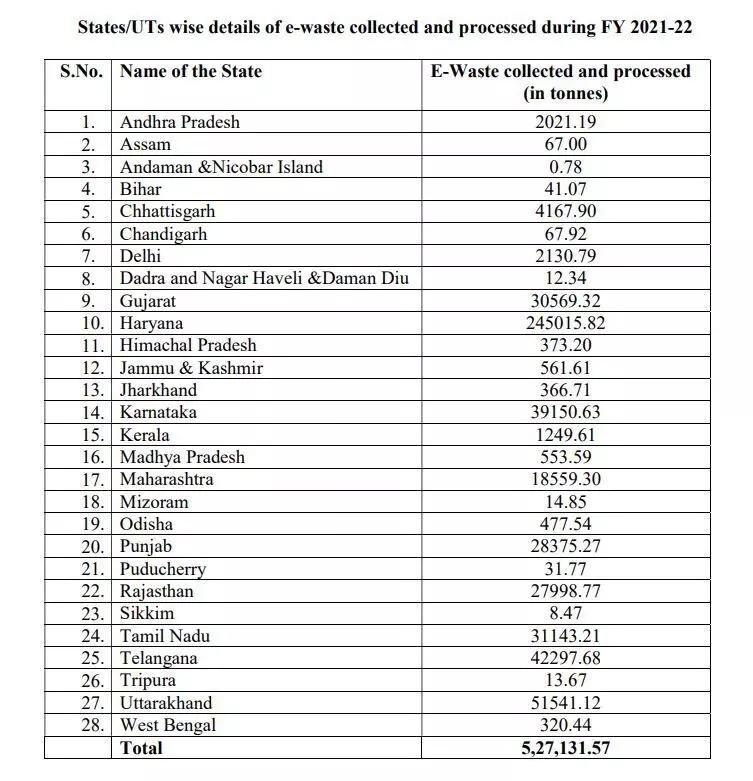In the ongoing Monsoon Session of the Parliament, the Union Ministry of Environment, Forest and Climate Change informed Rajya Sabha yesterday, on July 27, that the generation of electronic waste has more than doubled between 2017-2022.
As per the data tabled by Union Minister of State Ashwini Kumar Choubey, 7,08,445.00 tonnes [1 tonne= 1,000 kilogrammes] of e-waste was generated in 2017-18 while in 2021-22, it soared to 16,01,155.36 tonnes.
The United Nations defines e-waste as any discarded products with a battery or plug, and features toxic and hazardous substances such as mercury, that can pose severe risk to human and environmental health.

Gangur Cheluvegowda Chandrashekhar is the Member of Parliament in Rajya Sabha from Karnataka whom the Union Minister was replying to about the generation of e-waste. He also questioned the government whether India imports e-waste from developed countries and asked for the steps taken by the Union government to prevent the generation of e-waste.
Also Read: The Pandemic and Pollution: Handling the packaging waste of increased online shopping
“The import and export of hazardous and other wastes is regulated under the Hazardous and Other Wastes (Management and Transboundary Movement) Rules, 2016 notified by the Ministry. E-waste has been listed under Basel No. A1180 in the schedule VI of the said rules and prohibited for import,” the minister replied.

He also mentioned that the ministry has comprehensively revised the previous set of Rules and notified the E-Waste (Management) Rules, 2022 in November, 2022 and it is enforced since April 1, 2023.
“These new rules intend to manage e-waste in an environmentally sound manner and put in place an improved Extended Producer Responsibility (EPR) regime for e-waste recycling wherein all the manufacturer, producer, refurbisher and recycler are required to register on portal developed by CPCB [Central Pollution Control Board],” the minister replied.
“The new provisions would facilitate and channelize the informal sector to formal sector for doing business and ensure recycling of E-waste in environmentally sound manner. Provisions for environmental compensation and verification & audit have also been introduced. These rules also promote Circular Economy through EPR regime and scientific recycling/disposal of the e-waste,” he added.
Risks posed by e-waste
In a research study published on the The Lancet Planetary Health journal in December, 2021, it was stated that e-waste contains numerous chemicals harmful to human and ecological health.
“People living in e-waste exposed regions had significantly elevated levels of heavy metals and persistent organic pollutants. Children and pregnant women were especially susceptible during the critical periods of exposure that detrimentally affect diverse biological systems and organs. Elevated toxic chemicals negatively impact on neonatal growth indices and hormone level alterations in e-waste exposed populations,” the study titled Health consequences of exposure to e-waste: an updated systematic review mentioned.
The study also recorded possible connections between chronic exposure to e-waste and DNA lesions, inhibited vaccine responsiveness, elevated oxidative stress, and altered immune function.
“The existence of various toxic chemicals in e-waste recycling areas impose plausible adverse health outcomes. Novel cost-effective methods for safe recycling operations need to be employed in e-waste sites to ensure the health and safety of the vulnerable,” it added.
Also, Geneva Environment Network, which is a cooperative partnership of over 75 environment and sustainable development organisations, mentioned in its notes on e-waste that E-waste can be toxic, is not biodegradable and accumulates in the environment, in the soil, air, water and living things. For example, open-air burning and acid baths being used to recover valuable materials from electronic components release toxic materials leaching into the environment.
“These practices can also expose workers to high levels of contaminants such as lead, mercury, beryllium, thallium, cadmium and arsenic, and also brominated flame retardants (BFRs) and polychlorinated biphenyls, which can lead to irreversible health effects, including cancers, miscarriages, neurological damage and diminished IQs [intelligence quotient],” it mentioned.




















